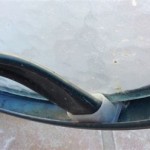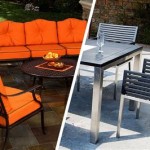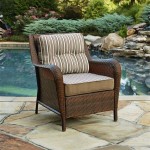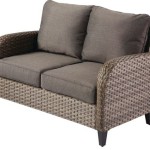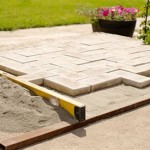Patio Cushion Storage Ideas: Protecting Your Outdoor Comfort
Patio cushions enhance the comfort and aesthetic appeal of outdoor living spaces. However, exposure to the elements can lead to fading, mildew, and premature wear. Proper storage is essential for prolonging the lifespan and maintaining the appearance of these cushions. This article explores various patio cushion storage ideas, offering solutions for different spaces, budgets, and aesthetic preferences.
The primary goal of cushion storage is to shield them from moisture, sunlight, and pests. Moisture, whether from rain, dew, or humidity, encourages mold and mildew growth. Sunlight causes fabric fading and deterioration. Pests like rodents and insects can use cushions as nesting material or food sources. Effective storage methods address these challenges, ensuring cushions remain clean, dry, and protected when not in use.
Selecting the Right Storage Solution: Key Considerations
Choosing the appropriate storage option requires evaluating available space, climate conditions, budget considerations, and aesthetic preferences. Before investing in a storage solution, consider these factors to ensure it meets specific needs and provides adequate protection for patio cushions.
First, assess the available space. Consider the size and shape of the patio area and the amount of space that can be dedicated to storage. Measure the cushions to determine the minimum dimensions required for the storage unit. Available storage space will dictate whether to opt for compact solutions, like storage benches, or larger options, such as deck boxes or repurposed indoor furniture.
Second, evaluate the local climate. In regions with frequent rainfall or high humidity, waterproof or water-resistant storage solutions are crucial. Consider storage options with ventilation to prevent moisture buildup. In areas with intense sunlight, UV-resistant materials are necessary to prevent fading and fabric damage. Consider the impact of temperature fluctuations on storage materials and cushion fabrics. Extreme temperatures can impact the longevity of both.
Third, establish a budget. Storage solutions range from inexpensive DIY options to high-end, weatherproof containers. Determine how much can be spent on storage without compromising other outdoor living investments. Explore different options within the budget range, comparing features, durability, and aesthetic appeal.
Fourth, consider aesthetic preferences. Storage solutions should complement the overall design of the patio area. Choose materials, colors, and styles that blend seamlessly with existing outdoor furniture and décor. A well-chosen storage solution not only protects cushions but also enhances the visual appeal of the outdoor space.
Types of Patio Cushion Storage
A variety of storage options cater to different needs and preferences. These include storage benches, deck boxes, cushion bags, repurposed furniture, and custom-built solutions. Each option offers its own set of advantages and disadvantages in terms of cost, space efficiency, weather resistance, and aesthetic appeal.
Storage Benches: Storage benches offer a dual function, providing seating and storage in one convenient unit. They are typically made from weather-resistant materials like wood, resin, or metal. Cushions can be stored inside the bench when not in use, keeping them protected from the elements. Storage benches are available in various sizes and styles, making them a versatile option for patios of all sizes.
The advantages of storage benches include their dual functionality, offering seating and storage in a single unit. They are also relatively compact and can be placed discreetly within the patio area. Many models are designed with weather-resistant materials, providing good protection against rain and sunlight.
The disadvantages of storage benches include limited storage capacity compared to larger options like deck boxes. Some models may require assembly and can be relatively heavy to move. The seating surface may not be as comfortable as dedicated outdoor furniture cushions.
Deck Boxes: Deck boxes are large, weatherproof containers designed specifically for outdoor storage. They are typically made from durable plastic or resin and offer ample space for storing multiple cushions, pillows, and other outdoor accessories. Deck boxes are available in various sizes and styles, ranging from small, compact units to large, extra-capacity models.
The advantages of deck boxes include their large storage capacity, providing ample space for multiple cushions and outdoor items. They are typically weatherproof, offering excellent protection against rain, sunlight, and pests. Many models are designed with wheels or handles for easy maneuverability.
The disadvantages of deck boxes include their large size, which may not be suitable for small patios or balconies. Some models may be less aesthetically pleasing than other storage options. While weatherproof, it is still advisable to line the bottom with a tarp or absorbent material in particularly wet climates.
Cushion Bags: Cushion bags are zippered bags made from water-resistant or waterproof material. They are designed specifically for storing cushions and protecting them from moisture, dirt, and pests. Cushion bags are available in various sizes to accommodate different cushion shapes and sizes. They are a convenient and portable storage option for smaller patios or when cushions need to be moved frequently.
The advantages of cushion bags include their portability, making it easy to move cushions between indoor and outdoor spaces. They are relatively inexpensive compared to other storage options. They offer good protection against moisture, dirt, and pests.
The disadvantages of cushion bags include their limited storage capacity, suitable only for storing cushions. They offer less protection against crushing or physical damage compared to rigid containers. They may require additional storage space in a shed or garage when not in use.
Repurposed Furniture: Existing indoor furniture can be repurposed for outdoor cushion storage. Old chests of drawers, cabinets, or trunks can be transformed into stylish and functional storage units. Repurposing furniture adds a unique and personalized touch to the patio area while providing a practical storage solution.
The advantages of repurposed furniture include its unique and personalized aesthetic, adding character to the patio area. It can be a cost-effective option, utilizing existing furniture instead of purchasing new storage units. It offers flexible storage configurations, depending on the type of furniture repurposed.
The disadvantages of repurposed furniture include the need for weatherproofing to protect the furniture from outdoor elements. It may require modifications or repairs to make it suitable for outdoor use. Storage capacity may be limited depending on the size and design of the furniture.
Custom Built Solutions: For those seeking a tailored and aesthetically integrated storage solution, custom-built options offer the ultimate flexibility. Custom storage can be designed to perfectly fit the patio space and accommodate specific storage needs. This option allows for the selection of materials, finishes, and design elements that complement the overall outdoor aesthetic.
The advantages of custom built solutions include a tailored design, perfectly fitting the patio space and storage requirements. This offers a cohesive aesthetic, blending seamlessly with the overall outdoor décor. Materials and finishes can be chosen to match the existing furniture and landscaping.
The disadvantages of custom built solutions include the higher cost compared to other storage options. It requires more time and effort for planning, design, and construction. Depending on the complexity of the design, it may require professional assistance.
Maintaining and Protecting Cushions in Storage
Regardless of the storage option chosen, proper maintenance is crucial for preserving cushions while in storage. This includes cleaning cushions before storing, using protective covers or liners, and implementing strategies to prevent moisture buildup and pest infestations.
Before placing cushions in storage, thoroughly clean them to remove dirt, stains, and debris. Use a mild soap and water solution to clean fabric cushions. For vinyl or plastic cushions, use a specialized cleaner designed for outdoor furniture. Allow cushions to dry completely before storing them to prevent mildew growth.
Utilize protective measures to further safeguard cushions within the storage unit. Wrap cushions in plastic sheeting or use fitted cushion covers to protect them from dust, dirt, and moisture. Consider placing desiccant packets within the storage unit to absorb excess moisture. This is particularly important in humid climates.
To further prevent moisture buildup, ensure the storage unit is well-ventilated. If using a deck box or storage bench, consider drilling small ventilation holes to allow air circulation. Elevate the cushions slightly off the floor of the storage unit to prevent moisture from seeping in from below.
Regularly inspect the storage unit for signs of pests, such as rodent droppings or insect nests. Take preventative measures to deter pests, such as placing mothballs or cedar chips inside the storage unit. Seal any cracks or openings in the storage unit to prevent pests from entering.

Outdoor Cushion Storage Shed Diy And Done The Inspired Room

17 Shed Organization Ideas To Keep Your Outdoor Supplies Neat And Tidy Patio Furniture Cushion Storage

This Is A Neat Idea I Had Come Up With Hanging Hooks From The Ceiling And Your Patio Chair Garage Storage Systems Cushion

Outdoor Cushion Storage Shed Diy And Done The Inspired Room
:max_bytes(150000):strip_icc()/sandandsisal-ad956a244b5d4eaeb7d4aee07d0ed4c3.jpg?strip=all)
Diy Outdoor Storage Ideas

Outdoor Cushion Storage Shed Diy And Done The Inspired Room

Outdoor Cushion Storage With Cover Patio Furniture Cushions

Patio Cushion Storage Diy Outdoor Cushions Garden

Outdoor Cushion Storage Shed Diy And Done The Inspired Room

Patio Cushion Storage Ideas On Foter In 2024 Furniture Outdoor Bench

